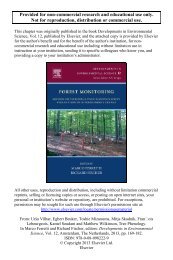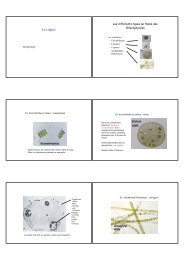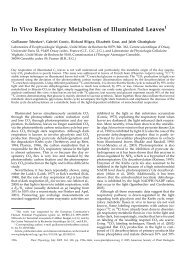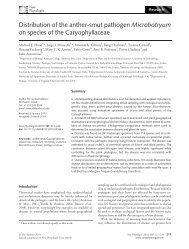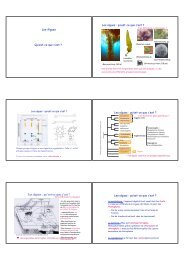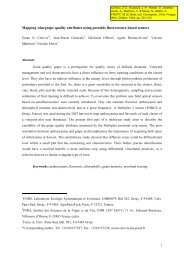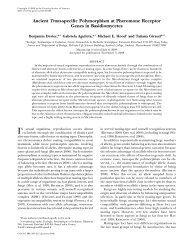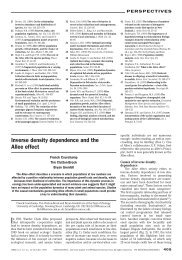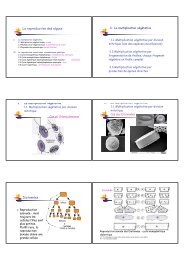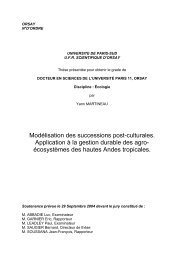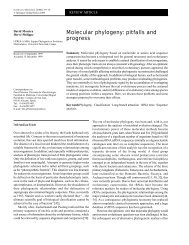environmental sex determination in the genus equisetum
environmental sex determination in the genus equisetum
environmental sex determination in the genus equisetum
Create successful ePaper yourself
Turn your PDF publications into a flip-book with our unique Google optimized e-Paper software.
Int. J. Plant Sci. 163(5):825–830. 2002. 2002 by The University of Chicago. All rights reserved.1058-5893/2002/16305-0014$15.00ENVIRONMENTAL SEX DETERMINATION IN THE GENUS EQUISETUM: SUGARSINDUCE MALE SEX EXPRESSION IN CULTURED GAMETOPHYTESJean-Michel Guillon 1, * , † and Christian Raqu<strong>in</strong>**Laboratoire Ecologie, Systématique et Evolution, Unité Propre de Recherche de l’Enseignement Supérieur Associée au Centre National de laRecherche Scientifique 8079, Université Paris-Sud, F-91405 Orsay Cedex, France; and †Conservatoire Botanique National duBass<strong>in</strong> Parisien, Muséum National d’Histoire Naturelle, 61 rue Buffon, F-75005 Paris, FranceHorsetails (Equisetum, Sphenophyta) are homosporous, and <strong>sex</strong>ual differentiation of Equisetum gametophytesis under <strong>the</strong> <strong>in</strong>fluence of <strong>environmental</strong> conditions. Still, <strong>the</strong> <strong>environmental</strong> cues responsible for <strong>sex</strong><strong>determ<strong>in</strong>ation</strong> of Equisetum gametophytes <strong>in</strong> vitro and <strong>in</strong> <strong>the</strong> wild have rema<strong>in</strong>ed elusive. Here, we show thatsignificantly different <strong>sex</strong> ratios are obta<strong>in</strong>ed when gametophytes are grown on media with or without sugar.In our experimental conditions, male gametophytes outnumber females <strong>in</strong> <strong>the</strong> presence of 60–120 mM sucroseand 120 mM glucose, whereas <strong>in</strong> <strong>the</strong> absence of sugar, most gametophytes differentiate as female. A similareffect is also observed on already differentiated female gametophytes, which become hermaphroditic soonerwhen cultured <strong>in</strong> <strong>the</strong> presence of sucrose <strong>in</strong> vitro. Interest<strong>in</strong>gly, <strong>the</strong>se results are reproducible with<strong>in</strong> and acrossspecies representative of <strong>the</strong> two subgenera Equisetum and Hippochaete, <strong>in</strong>dicat<strong>in</strong>g that <strong>the</strong> entire <strong>genus</strong> mayshare an identical pattern of <strong>environmental</strong> <strong>sex</strong> <strong>determ<strong>in</strong>ation</strong>.Keywords: <strong>sex</strong> <strong>determ<strong>in</strong>ation</strong>, Equisetum, environment, gametophyte, <strong>in</strong> vitro culture, sugars.IntroductionSeedless vascular plants are a paraphyletic group of plantscharacterized by a haplo-diplophasic life cycle. Among <strong>the</strong>se,Isoetaceae, Selag<strong>in</strong>ellaceae, and Marsileaceae are heterosporous,i.e., produc<strong>in</strong>g micro- and macrospores that differ <strong>in</strong>morphology, whereas club mosses (Lycopodium), horsetails(Equisetum), and most ferns (Filicophyta) are homosporous.In Equisetum, perennial sporophytes (2n) produce <strong>sex</strong>uallyundifferentiated spores (n) that are dispersed and germ<strong>in</strong>ateto form photosyn<strong>the</strong>tic male, female, or sometimes bi<strong>sex</strong>ualgametophytes (n). Fertilizations between male and female gametes(n) result <strong>in</strong> <strong>the</strong> formation of new sporophytes.The <strong>sex</strong>ual <strong>determ<strong>in</strong>ation</strong> of Equisetum gametophytes hasbeen problematic for many years, with various authors emphasiz<strong>in</strong>ggenetic <strong>sex</strong> <strong>determ<strong>in</strong>ation</strong>, <strong>environmental</strong> <strong>sex</strong> <strong>determ<strong>in</strong>ation</strong>,or a mixture of both (Mohan Ram and Chatterjee1970; Laroche et al. 1972, 1978; Hauke 1977). However, <strong>the</strong>observations that (i) archegonial (female) gametophytes alwayschange to an<strong>the</strong>ridial (male) lobe production when culturedover a prolonged time, (ii) secondary archegonial branches canbe regenerated from o<strong>the</strong>rwise purely male gametophytes, and(iii) <strong>the</strong> proportions of male and female gametophytes develop<strong>in</strong>gfrom <strong>the</strong> same <strong>in</strong>itial set of spores are highly sensitiveto growth conditions all <strong>in</strong>dicate that <strong>the</strong> spores of Equisetumare not <strong>in</strong>dividually predeterm<strong>in</strong>ed for <strong>the</strong> expression of one<strong>sex</strong> or <strong>the</strong> o<strong>the</strong>r (Duckett 1970, 1972, 1977, 1979). Instead,1Author for correspondence; address for correspondence: LaboratoireEcologie, Systématique et Evolution, Université Paris-Sud, Bâtiment362, F-91405 Orsay Cedex, France; telephone 33-1-69-15-63-42; fax 33-1-69-15-73-53; e-mail jean-michel.guillon@ese.u-psud.fr.Manuscript received October 2001; revised manuscript received March 2002.<strong>in</strong> each develop<strong>in</strong>g gametophyte, a series of threshold conditionsappears to determ<strong>in</strong>e which <strong>sex</strong> is expressed (Duckett1977).To better understand <strong>sex</strong> <strong>determ<strong>in</strong>ation</strong> <strong>in</strong> Equisetum gametophytes,several authors have studied <strong>the</strong>ir response to anumber of culture conditions <strong>in</strong> vitro (Mohan Ram and Chatterjee1970; Hauke 1971, 1977). Studied <strong>environmental</strong> factors<strong>in</strong>clude light quality and level, crowd<strong>in</strong>g, pH, and sucroseconcentration <strong>in</strong> <strong>the</strong> culture media. Although each of <strong>the</strong>sefactors seems able to affect <strong>the</strong> <strong>sex</strong> ratio, <strong>in</strong> many cases, <strong>the</strong>effects are not consistent among different species. For example,sucrose enrichment has been reported (i) to <strong>in</strong>hibit female <strong>sex</strong>differentiation <strong>in</strong> Equisetum ramosissimum (Mohan Ram andChatterjee 1970), (ii) to decrease <strong>the</strong> proportion of males <strong>in</strong>Equisetum arvense (Hauke 1971, 1977), (iii) to <strong>in</strong>crease <strong>the</strong>proportion of males <strong>in</strong> E. ramosissimum (Mohan Ram andChatterjee 1970) and Equisetum hyemale (Hauke 1971), or(iv) to have no effect on <strong>sex</strong> expression <strong>in</strong> <strong>the</strong> same E. hyemale(Hauke 1977). Hauke (1977) concluded: “A number of experimentsutiliz<strong>in</strong>g sugar enrichment were attempted, but <strong>the</strong>results were so <strong>in</strong>consistent that no conclusions can be drawnfrom <strong>the</strong>m” (p. 29). Such discrepancies may be expla<strong>in</strong>ed byvariations <strong>in</strong> culture conditions between experiments, lead<strong>in</strong>gto <strong>the</strong> <strong>in</strong>teraction of o<strong>the</strong>r important factors such as light qualityand crowd<strong>in</strong>g. Alternatively, <strong>the</strong>re may be variability amongspores collected from different <strong>in</strong>dividuals of <strong>the</strong> same speciesand/or from <strong>in</strong>dividuals of different species.In an attempt to characterize <strong>the</strong> pattern of <strong>sex</strong> expression<strong>in</strong> Equisetum gametophytes from different species, we conductedrepeated and controlled culture experiments <strong>in</strong> <strong>the</strong> presenceof various sugar concentrations. Also, we exam<strong>in</strong>ed <strong>the</strong>stages dur<strong>in</strong>g which <strong>sex</strong> differentiation can be modified bysugar. Here, we present evidence that <strong>the</strong> male-promot<strong>in</strong>g ef-825
826 INTERNATIONAL JOURNAL OF PLANT SCIENCESfect of sucrose and glucose <strong>in</strong> <strong>the</strong> culture medium is significantand can be reproduced with<strong>in</strong> and across species of Equisetum.We also show that <strong>the</strong> addition of sucrose to <strong>the</strong> culture mediumcan <strong>in</strong>duce mature female gametophytes to change <strong>sex</strong>.The significance of this f<strong>in</strong>d<strong>in</strong>g is discussed <strong>in</strong> relation to lifehistory <strong>in</strong> this ancestral l<strong>in</strong>eage of plants and <strong>in</strong> <strong>the</strong> light ofevolutionary <strong>the</strong>ories of <strong>sex</strong> <strong>determ<strong>in</strong>ation</strong>.Material and MethodsSpore Collection and StorageSpores were collected from one cone per plant. For eachEquisetum species, plants from two dist<strong>in</strong>ct localities were usedas sources of spores. Equisetum palustre L.: P11, P12, CampusUniversity Paris XI, Orsay, France; P2, nor<strong>the</strong>rn bank of <strong>the</strong>Great Pond, Sa<strong>in</strong>t-Mars-La-Brière, France. Equisetum arvenseL.: A1, Campus University Paris XI, Orsay, France; A2, CampusUniversity Paris XI, Bures-sur-Yvette, France. Equisetumtelmateia Ehrh.: T1, Campus University Paris XI, Orsay,France; T2, Moul<strong>in</strong> de la Mare, Milon-La-Chapelle, France.Equisetum variegatum Schleich.: plants cultivated <strong>in</strong> <strong>the</strong> ConservatoireNational Botanique du Bass<strong>in</strong> Parisien and orig<strong>in</strong>at<strong>in</strong>gfrom (V1) Forest of Marly, Marly, France, and (V2)Botanical garden, Samoens, France.For E. variegatum and E. palustre, spores were collectedfrom mature cones and stored <strong>in</strong> hermetically closed tubes at70C. For E. arvense and E. telmateia, mature but unopenedcones were harvested and sterilized for 5 m<strong>in</strong> <strong>in</strong> 10 g L 1 ofcalcium hypochlorite to which 50 mL of Teepol (Lever) detergentper 100 mL was added. Cones were r<strong>in</strong>sed <strong>in</strong> distilledwater, allowed to dry overnight, and <strong>the</strong>n dissected to release<strong>the</strong> spores, which were stored as above.In Vitro CultureG0 culture medium conta<strong>in</strong>ed <strong>the</strong> macronutrients of Estelleand Sommerville (1987): 2.5 mM KH 2 PO 4 replaced by 2 mMKH 2 PO 4 and 0.5 mM K 2 HPO 4 so that <strong>the</strong> medium was directlybuffered to pH 6.1, <strong>the</strong> m<strong>in</strong>eral micronutrients of Murashigeand Skoog (1962) diluted by half, and 10 mM Fe EDTA. Phytagel(0.2% w/v; Sigma) and agar (0.4% w/v; Biofit, Fisher)were used as gell<strong>in</strong>g agents before autoclav<strong>in</strong>g for 12 m<strong>in</strong> at120C.Whereas G0 conta<strong>in</strong>ed no additional component, 120 mMglucose was added to G120G, 30 mM sucrose was added toG30S, 60 mM sucrose was added to G60S, 90 mM sucrosewas added to G90S, and 120 mM sucrose was added to G120S.Sixty mM mannitol was added to G60ML for a control as anunmetabolized osmotic agent. Sugars or mannitol were addedto <strong>the</strong> culture medium before sterilization: sucrose and glucose(Prolabo, RP NORMAPUR) and mannitol (Merck).Gametophyte cultures were placed <strong>in</strong> a growth chamber atconstant 241C and 24 3 mmol m 2 s 1 of photosyn<strong>the</strong>ticallyactive radiation for 16 h d 1 provided by fluorescentlamps, a 1/1 mixture of Philips TLD36W82, 2700K, andTLD36W33, 4000K.For <strong>the</strong> primary <strong>sex</strong>ual differentiation experiment, at t p10 d, spores were sown on G0 petri dishes and <strong>the</strong>n placed<strong>in</strong> <strong>the</strong> growth chamber. At t p 0, gametophytes were trans-ferred to test-media dishes. Test media were G0, G30S, G60S,G90S, G120S, G120G, and G60ML. Sixteen randomly chosengametophytes were transferred to each test-medium dish, wi<strong>the</strong>ach medium replicated <strong>in</strong> three dishes (for P11 and V1) orfour dishes (for P2, V2, A1, A2, T1, T2). The gametophyteswere observed under a b<strong>in</strong>ocular dissect<strong>in</strong>g microscope everyweek after transfer to <strong>the</strong> test media until <strong>the</strong> end of <strong>the</strong> experiment.For each gametophyte, viability and gender weredeterm<strong>in</strong>ed accord<strong>in</strong>g to <strong>the</strong> presence or absence of an<strong>the</strong>ridiaand archegonia, with each gametophyte recorded as female,male, bi<strong>sex</strong>ual, undifferentiated, or dead. At <strong>the</strong> end of <strong>the</strong>experiment, 5 wk for E. telmateia, 8 wk for E. arvense andE. variegatum,and9wkforE. palustre, pairs of gametophyteswere transferred <strong>in</strong>to a flooded G30S tube to assess <strong>the</strong> fertilityof some of <strong>the</strong> males and females grown on G0, G30S, G90S,and G120S. In all cultures, a sporophyte developed after3–4 wk, <strong>in</strong>dicat<strong>in</strong>g that <strong>the</strong> <strong>sex</strong> organs and gametes werefunctional.For hermaphroditization experiments, spores were sown onG0 dishes, and gametophytes were transferred to G0 for primary<strong>sex</strong> expression. When <strong>the</strong> gender of gametophytes couldbe determ<strong>in</strong>ed, female gametophytes were transferred to testmedia and fur<strong>the</strong>r grown as above. N<strong>in</strong>e randomly chosenfemale gametophytes for P12 and 12 female gametophytes forT2 and V1 were transferred to each test-medium dish, andeach medium was replicated over three dishes. The female gametophyteswere observed every week after transfer to <strong>the</strong> testmediumplates, and <strong>the</strong> appearance of an<strong>the</strong>ridia was recorded.Statistical AnalysesThe statistical analyses <strong>in</strong>cluded only plates <strong>in</strong> which lessthan three gametophytes failed to grow or to differentiate( undifferentiated + dead ! 3). In <strong>the</strong> early <strong>sex</strong>-differentiationexperiment, <strong>the</strong> <strong>sex</strong> ratio was def<strong>in</strong>ed as ( males + bi<strong>sex</strong>uals)/( males + bi<strong>sex</strong>uals + females), account<strong>in</strong>g for <strong>the</strong> observationof male <strong>sex</strong> expression both <strong>in</strong> <strong>in</strong>itially male gametophytesand <strong>in</strong> rare bi<strong>sex</strong>uals deriv<strong>in</strong>g from <strong>in</strong>itially female gametophytes.The <strong>sex</strong> ratio on each plate was square root– andarcs<strong>in</strong>e-transformed and <strong>the</strong>n submitted to ANOVA, withtest medium and plant species as fixed effects and plantorig<strong>in</strong> (nested with<strong>in</strong> species) as a random effect (generall<strong>in</strong>ear models procedure; SAS Institute 1988). In <strong>the</strong> hermaphroditizationexperiment, where only one plant per specieswas used, <strong>the</strong> statistical treatment was <strong>the</strong> same asabove, except that <strong>the</strong> <strong>sex</strong> ratio on each plate was def<strong>in</strong>edas bi<strong>sex</strong>uals/(bi<strong>sex</strong>uals + females) and that <strong>the</strong> only effect <strong>in</strong>-cluded <strong>in</strong> <strong>the</strong> model was test medium. Tukey’s studentizedrange test was performed for multiple comparisons. Therelation between sucrose concentration and <strong>the</strong> <strong>sex</strong> ratioobta<strong>in</strong>ed on each dish was assessed by us<strong>in</strong>g <strong>the</strong> SAS regressionprocedure.ResultsTo test <strong>the</strong> effect of sugar addition on <strong>sex</strong> expression <strong>in</strong> fourspecies of Equisetum, we performed two different experiments,exam<strong>in</strong><strong>in</strong>g <strong>the</strong> <strong>in</strong>fluence of growth medium on <strong>sex</strong> expression,start<strong>in</strong>g with ei<strong>the</strong>r 11-d-old undifferentiated Equisetum gametophytes(table 1; fig. 1) or older differentiated female Equisetumgametophytes (fig. 2).
828 INTERNATIONAL JOURNAL OF PLANT SCIENCESFig. 1 Sex ratios <strong>in</strong> cultures of Equisetum gametophytes. For each plant, bars represent <strong>the</strong> mean <strong>sex</strong> ratio ([ male + bi<strong>sex</strong>ual]/[ male + bi<strong>sex</strong>ual + female]) and associated standard error obta<strong>in</strong>ed on <strong>the</strong> correspond<strong>in</strong>g test medium. The number of repeats (n) and <strong>the</strong> resultof multiple comparisons (Tukey’s studentized range test) are also <strong>in</strong>dicated. Treatments with <strong>the</strong> same letter do not significantly differ (P 10.05). Treatments that differ from G0 ( P ! 0.05) are <strong>in</strong>dicated with bars <strong>in</strong> black. The duration of growth on test media is specified with <strong>the</strong>name of <strong>the</strong> plant. A1 and A2, Equisetum arvense; P11 and P2, Equisetum palustre; T1 and T2, Equisetum telmateia; V1 and V2, Equisetumvariegatum.stress could account <strong>in</strong> part for <strong>the</strong> observed effect because <strong>the</strong>addition of an osmotic agent, 60 mM mannitol, or a sugar,60 mM sucrose, produced similar <strong>sex</strong> ratios (fig. 1). Higherconcentrations of mannitol should be used to test thishypo<strong>the</strong>sis.When review<strong>in</strong>g <strong>the</strong> variations <strong>in</strong> <strong>sex</strong> ratio of cultured Equisetumgametophytes, <strong>in</strong>vestigators have noticed that underconditions favor<strong>in</strong>g vigorous vegetative growth of young gametophytes,e.g., high light levels, most spores differentiate<strong>in</strong>to <strong>in</strong>itially female <strong>in</strong>dividuals (Duckett 1970). However, less
GUILLON & RAQUIN—SEX DETERMINATION IN EQUISETUM 829Fig. 2 Tim<strong>in</strong>g of hermaphrodite appearance <strong>in</strong> <strong>in</strong>itially femalegametophyte cultures of P12 (Equisetum palustre), T2 (Equisetum telmateia),and V1 (Equisetum variegatum). For each plant and test medium,<strong>the</strong> mean <strong>sex</strong> ratio with its associated standard error is shownas a function of time. Each treatment was replicated <strong>in</strong> three dishes.Circles, G0 (no sucrose added); squares, G60S (60 mM sucrose); triangles,G90S (90 mM sucrose).favorable regimes, e.g., crowd<strong>in</strong>g, drought, m<strong>in</strong>eral deficiency,or high temperatures, produce a majority of males (Duckett1970; Mohan Ram and Chatterjee 1970; Hauke 1977). Observationsof wild populations of Equisetum gametophyteshave shown that high frequencies of males correspond withlow growth rates, possibly result<strong>in</strong>g from <strong>environmental</strong> stress(Duckett and Duckett 1980). Environmental factors are alsoknown to <strong>in</strong>fluence <strong>sex</strong> ratios <strong>in</strong> several seed plant species,with males most typically tend<strong>in</strong>g to be overrepresented <strong>in</strong>resource-limited or less favorable environments (Lloyd andBawa 1984; Korpela<strong>in</strong>en 1998). This general pattern of observationsis consistent with <strong>the</strong> hypo<strong>the</strong>sis that exogenous sugarscould be a stress to cultured gametophytes of Equisetum.Evolutionary Significance of Sex Determ<strong>in</strong>ation<strong>in</strong> Equisetum GametophytesEquisetum species have a haplo-diplophasic life cycle, characterizedby <strong>the</strong> alternation of a perennial sporophytic generationand a short-lived gametophytic generation. Not all sporophytepopulations produce spores, and <strong>the</strong>y can propagateefficiently through vegetative reproduction. New populationsmay be founded ei<strong>the</strong>r by broken-off or dispersed vegetativeparts of <strong>the</strong> sporophytes or by dispersed spores and <strong>sex</strong>ualreproduction between emerg<strong>in</strong>g gametophytes. Studies of geneticdiversity <strong>in</strong> E. arvense and Equisetum hyemale populations,as well as high fertilization rates found <strong>in</strong> wild gametophytepopulations, <strong>in</strong>dicate that <strong>sex</strong>ual reproduction occursand cannot be dismissed as marg<strong>in</strong>al <strong>in</strong> Equisetum (Duckettand Duckett 1980; Soltis et al. 1988; Korpela<strong>in</strong>en and Kolkkala1996).In <strong>the</strong> wild, observed differences <strong>in</strong> <strong>sex</strong> ratios between populationsof <strong>the</strong> same species at <strong>the</strong> same time and betweenpopulations at <strong>the</strong> same locality <strong>in</strong> different years all <strong>in</strong>dicatean important <strong>environmental</strong> component for <strong>sex</strong> <strong>determ<strong>in</strong>ation</strong><strong>in</strong> Equisetum (Duckett and Duckett 1980). Evolutionary <strong>the</strong>oriespredict that <strong>environmental</strong> <strong>sex</strong> <strong>determ<strong>in</strong>ation</strong> is favored(i) when early <strong>in</strong> life, an <strong>in</strong>dividual enters a patchy environmentthat has a large effect on its lifetime fitness (some patches be<strong>in</strong>grelatively more beneficial to females than to males and somebe<strong>in</strong>g <strong>the</strong> opposite), (ii) when <strong>in</strong>dividuals have little controlover which patch <strong>the</strong>y enter, and (iii) when <strong>in</strong>dividuals fromdifferent patches mate randomly (Charnov and Bull 1977; Bull1981). Equisetum gametophytes might fit this model if naturalpopulations <strong>in</strong>habited patchy places made of microenvironmentsconferr<strong>in</strong>g more or less an advantage to one <strong>sex</strong>. It hasalso been shown that short-lived species are less prone toevolve <strong>environmental</strong> <strong>sex</strong> <strong>determ<strong>in</strong>ation</strong> because <strong>environmental</strong>fluctuations may cause detrimental <strong>sex</strong>-ratio variations <strong>in</strong>such a system (Bull and Bulmer 1989). For this reason, strong<strong>sex</strong>-specific fitness effects of <strong>the</strong> environment would be expected<strong>in</strong> order to expla<strong>in</strong> <strong>the</strong> occurrence of <strong>environmental</strong> <strong>sex</strong><strong>determ<strong>in</strong>ation</strong> <strong>in</strong> <strong>the</strong> seasonal Equisetum gametophytes <strong>in</strong> <strong>the</strong>wild. S<strong>in</strong>ce <strong>the</strong> literature does not provide such fitness-relateddata, new work is clearly needed to exam<strong>in</strong>e whe<strong>the</strong>r <strong>the</strong> biologyof Equisetum gametophytes conforms to <strong>the</strong> predictionsof <strong>the</strong> Charnov and Bull (1977) model.As shown here, male <strong>sex</strong> expression can be <strong>in</strong>duced <strong>in</strong> fourspecies of Equisetum by <strong>the</strong> addition of sugar to <strong>the</strong> growthmedium. However, <strong>the</strong> addition of sugar <strong>in</strong> our experimentaldesign does not mimic any specific <strong>environmental</strong> factor thatgametophytes would encounter <strong>in</strong> <strong>the</strong> wild. Hence, <strong>sex</strong> <strong>determ<strong>in</strong>ation</strong><strong>in</strong> response to sugar concentration is unlikely to haveevolved per se, but exogenous sugars must somehow <strong>in</strong>terferewith <strong>the</strong> physiology of <strong>the</strong> develop<strong>in</strong>g gametophyte <strong>in</strong> such away that <strong>sex</strong> <strong>determ<strong>in</strong>ation</strong> is affected. Sex <strong>determ<strong>in</strong>ation</strong> <strong>in</strong>horsetails seems to <strong>in</strong>tegrate many physiological signals aris<strong>in</strong>gfrom <strong>the</strong> <strong>in</strong>teraction of <strong>the</strong> gametophyte with its environment.Indeed, many <strong>environmental</strong> factors, such as light quality andlevel, competition, and pH, are also able to modify <strong>sex</strong> expression<strong>in</strong> Equisetum gametophytes (Mohan Ram and Chatterjee1970; Hauke 1971, 1977). In this context, it is quiteunderstandable that sugar concentration <strong>in</strong> <strong>the</strong> growth mediumis one among many factors that <strong>in</strong>fluence <strong>sex</strong> <strong>determ<strong>in</strong>ation</strong>of gametophytes cultured <strong>in</strong> vitro.Lability of <strong>sex</strong> expression occurs <strong>in</strong> many plant taxa, butonly <strong>in</strong> homosporous pteridophytes is labile <strong>sex</strong> <strong>the</strong> rule (Korpela<strong>in</strong>en1998). Indeed, <strong>sex</strong> <strong>determ<strong>in</strong>ation</strong> <strong>in</strong> horsetails is rem<strong>in</strong>iscentof that found <strong>in</strong> ferns, where undifferentiated game-
830 INTERNATIONAL JOURNAL OF PLANT SCIENCEStophytes respond to an<strong>the</strong>ridogen hormones secreted by femalegametophytes. The evolutionary significance of this <strong>in</strong>formationsystem <strong>in</strong> fern gametophytes is still a matter of debate(Willson 1981; Haig and Westoby 1988; Korpela<strong>in</strong>en 1998).Because ferns and horsetails are sister clades (Kenrick andCrane 1997; Pryer et al. 2001), <strong>sex</strong> <strong>determ<strong>in</strong>ation</strong> <strong>in</strong> horsetailscould be evolutionarily related to that found <strong>in</strong> ferns, but an<strong>the</strong>ridogenhormones have not been detected <strong>in</strong> horsetails(Hauke 1971). Alternatively, <strong>environmental</strong> <strong>sex</strong> <strong>determ<strong>in</strong>ation</strong>might have evolved more than once <strong>in</strong> relation to <strong>the</strong> dist<strong>in</strong>ctivelife history of ferns and horsetails because <strong>the</strong>y both are homosporoushaplo-diplophasic land plants with perennial sporophytesand autonomous short-lived gametophytes. In particular,it has been proposed that <strong>the</strong> extreme lability <strong>in</strong> <strong>the</strong><strong>sex</strong> expression of homosporous pteridophytes may be primarilyrelated to <strong>the</strong>ir peculiar mat<strong>in</strong>g system (Korpela<strong>in</strong>en1998).AcknowledgmentsWe would like to thank Jacques Moret and <strong>the</strong> people at<strong>the</strong> Conservatoire Botanique National du Bass<strong>in</strong> Parisien for<strong>the</strong>ir support of this work. We thank Claire Lavigne, MarcGirondot, Bryan Epperson, and Jacqui Shykoff for discussionsand useful comments on <strong>the</strong> manuscript. Odylle Cudelou, OliviaCalvez, Alexandra Deville, and Amélie P<strong>in</strong>ot are acknowledgedfor <strong>the</strong>ir help <strong>in</strong> gametophyte culture.Literature CitedBull JJ 1981 Evolution of <strong>environmental</strong> <strong>sex</strong> <strong>determ<strong>in</strong>ation</strong> from genotypic<strong>sex</strong> <strong>determ<strong>in</strong>ation</strong>. Heredity 47:173–184.Bull JJ, MG Bulmer 1989 Longevity enhances selection of <strong>environmental</strong><strong>sex</strong> <strong>determ<strong>in</strong>ation</strong>. Heredity 63:315–320.Charnov EL, JJ Bull 1977 When is <strong>sex</strong> <strong>environmental</strong>ly determ<strong>in</strong>ed?Nature 266:828–830.Duckett JG 1970 Sexual behaviour of <strong>the</strong> <strong>genus</strong> Equisetum, sub<strong>genus</strong>Equisetum. Bot J L<strong>in</strong>n Soc 63:327–352.——— 1972 Sexual behaviour of <strong>the</strong> <strong>genus</strong> Equisetum, sub<strong>genus</strong>Hippochaete. Bot J L<strong>in</strong>n Soc 65:87–108.——— 1977 Towards an understand<strong>in</strong>g of <strong>sex</strong> <strong>determ<strong>in</strong>ation</strong> <strong>in</strong> Equisetum:an analysis of regeneration <strong>in</strong> gametophytes of <strong>the</strong> sub<strong>genus</strong>Equisetum. Bot J L<strong>in</strong>n Soc 74:215–242.——— 1979 Comparative morphology of <strong>the</strong> gametophytes of Equisetum,sub<strong>genus</strong> Hippochaete and <strong>the</strong> <strong>sex</strong>ual behaviour of E. ramosissimumsubsp. debile, (Roxb.), E. hyemale var. aff<strong>in</strong>e (Engelm.)A.A., and E. laevigatum A.Br. Bot J L<strong>in</strong>n Soc 79:179–203.Duckett JG, AR Duckett 1980 Reproductive biology and populationdynamics of wild gametophytes of Equisetum. Bot J L<strong>in</strong>n Soc 80:1–40.Estelle MA, C Sommerville 1987 Aux<strong>in</strong> resistant mutants of Arabidopsisthaliana with an altered morphology. Mol Gen Genet 207:200–206.Haig D, M Westoby 1988 Sex expression <strong>in</strong> homosporous ferns: anevolutionary perspective. Evol Trends Plants 2:111–119.Hauke RL 1971 The effect of light quality and <strong>in</strong>tensity on <strong>sex</strong>ualexpression <strong>in</strong> Equisetum gametophytes. Am J Bot 58:373–377.——— 1977 Experimental studies on growth and <strong>sex</strong>ual <strong>determ<strong>in</strong>ation</strong><strong>in</strong> Equisetum gametophytes. Am Fern J 67:18–31.Kenrick P, PR Crane 1997 The orig<strong>in</strong> and early evolution of plantson land. Nature 389:33–39.Korpela<strong>in</strong>en H 1998 Labile <strong>sex</strong> expression <strong>in</strong> plants. Biol Rev 73:157–180.Korpela<strong>in</strong>en H, M Kolkkala 1996 Genetic diversity and populationstructure <strong>in</strong> <strong>the</strong> outcross<strong>in</strong>g populations of Equisetum arvense andE. hyemale (Equisetaceae). Am J Bot 83:58–62.Laroche J, C Guerv<strong>in</strong>, C Le Coq 1978 Le génome et l’expression<strong>sex</strong>uelle chez l’Equisetum arvense L. I. Comportement du gamétophytecultivé sur milieu témo<strong>in</strong>. Rev Gen Bot 85:221–254.Laroche J, Van Thi Dao 1972 Peut-on admettre un déterm<strong>in</strong>isme génétiquedu <strong>sex</strong>e chez certa<strong>in</strong>es espèces d’Equisetum? Bull Soc BotFr 119:363–372.Lloyd DG, KS Bawa 1984 Modification of <strong>the</strong> gender of seed plants<strong>in</strong> vary<strong>in</strong>g conditions. Evol Biol 17:255–338.Mohan Ram HY, J Chatterjee 1970 Gametophytes of Equisetum ramosissimumsubsp. ramosissimum. II. Sexuality and its modification.Phytomorphology 20:151–172.Murashige T, F Skoog 1962 A revised medium for rapid growth andbioassays with tobacco tissue culture. Physiol Plant 15:473–497.Pryer KM, H Schneider, AR Smith, R Cranfill, PG Wolf, JS Hunt, SDSipes 2001 Horsetails and ferns are a monophyletic group and <strong>the</strong>closest liv<strong>in</strong>g relatives to seed plants. Nature 409:618–621.SAS Institute 1988 SAS/STAT user’s guide, release 6.03 ed. SAS Institute,Cary, N.C.Soltis DE, PS Soltis, RD Noyes 1988 An electrophoretic <strong>in</strong>vestigationof <strong>in</strong>tragametophytic self<strong>in</strong>g <strong>in</strong> Equisetum arvense. Am J Bot 75:231–237.Willson MF 1981 Sex expression <strong>in</strong> fern gametophytes: some evolutionarypossibilities. J Theor Biol 93:403–409.



